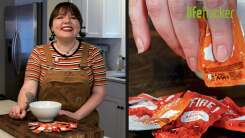Brine Your Holiday Meats in Shio Koji
Cooking and serving a large piece of meat for a holiday meal can make one feel like an (evil and rich) Dickens character, but buying large cuts for a crowd is far more cost effective (and less wasteful) than buying individual steaks or chops. But scale is not enough: These large animal parts deserve to be permeated with flavor, and shio koji is the easiest way to do this.
For those not familiar with inoculated rice, you can read both of these blogs, but to recap:
If koji sounds familiar, it’s because we’ve used the inoculated, fuzzy rice to
fake age some steaks
to excellent results. When mixed with salt and plain water and allowed to sit around, that same rice ferments and becomes shio koji (or “salt koji”), a traditional miso-esque Japanese paste that coaxes out flavor, tenderizes, encourages browning, and adds a sweet, savory depth to all sorts of foods.
In short, shio koji (salt koji) seasons and tenderizes your meat, while giving it a meatier, funkier, aged flavor profile (without any aging). Smear a meat with shio koji, wait 12-24 hours, then cook it however you usually would.

I use it to make incredible pork tenderloin, and you can find recipes for koji duck confit, koji chicken, koji turkey, and koji prime rib, but you don’t really need a proper recipe.
You can either pulverize the dry inoculated rice and spread it directly on the meat (which is what I did with these steaks), or you can mix the rice with water and salt and let it ferment for a week or two.
I prefer the paste. It’s easier to apply to the meat, it provides plenty salt, and it coaxes out a deeper, funkier flavor. You can buy the paste at most Asian grocery stores (or online), or you can buy the rice and make it yourself, which I recommend. It will take at least a week of hanging out to get it where you want it (two if your kitchen is cold) but the flavor bomb you’ll be rewarded with is well worth the wait. (Make it now, though—Christmas is coming.)
Once it’s made, just smear a cup or two on your meat of choice, and wait at least 12 hours, preferably 24. Wipe the paste off, and cook your meat however you usually would. I like to do a reverse sear. For smaller cuts, cook the meat in a 200℉ oven until it is 15 degrees shy of your target temperature, then immediately finish in a hot pan on the stove. For larger cuts, cook in a low-temp oven until you reach your target temp, let rest for half an hour, then finish under a super hot broiler (like 500℉) to crisp up the exterior.
RECOMMENDED NEWS

The Easiest Way to Make Beautiful, Flawless Turkey Stock
If you’re haven’t started on your Thanksgiving prep yet, making turkey stock is a good place to star...

You Should Absolutely Freeze a Baked Sweet Potato Into a Popsicle
Even before I saw the Eater article on the majesty of frozen sweet potatoes, I knew I had to try one...

There's More Than One Way to Make 'Authentic' Cornbread
Few dishes are as political and polarizing as cornbread. If you think the pineapple on pizza debate ...

You Don't Have to Peel Ginger
I have gotten more discerning about most things as I age, but the longer I am alive, the less picky ...

This Simple Texas Chili Makes an Incredible Frito Pie
Hello, friends, and welcome to the first installment of the Skillet Chili Cook-Off. Let me start out...

Jazz Up Desserts With a Microwave Fruit Compote
Fruit compote is one of the simplest ways to add a bright and sophisticated component to anything fr...
Comments on "Brine Your Holiday Meats in Shio Koji" :